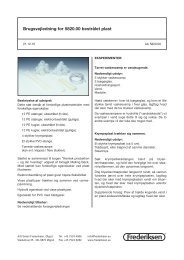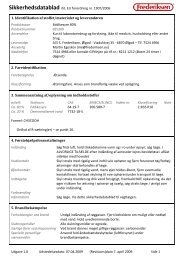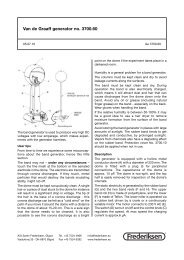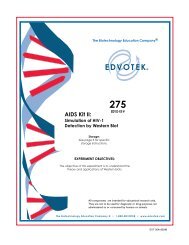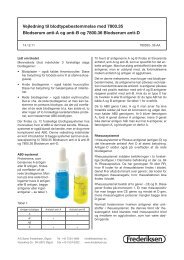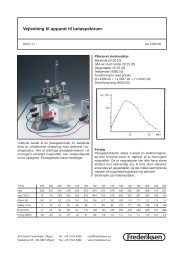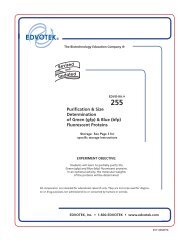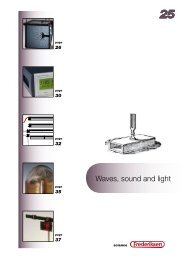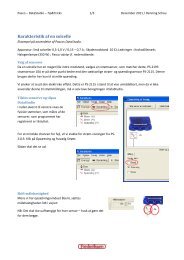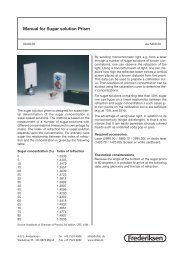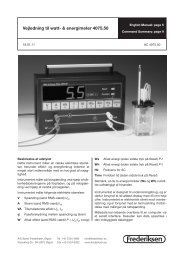Isolation of DNA from Onions - NanoGen
Isolation of DNA from Onions - NanoGen
Isolation of DNA from Onions - NanoGen
You also want an ePaper? Increase the reach of your titles
YUMPU automatically turns print PDFs into web optimized ePapers that Google loves.
<strong>Isolation</strong> <strong>of</strong> <strong>DNA</strong> <strong>from</strong> <strong>Onions</strong><br />
Page 1 <strong>of</strong> 4<br />
Document # WR2-031<br />
An educational resource <strong>from</strong><br />
www.edvotek.com<br />
Extracting <strong>DNA</strong> <strong>from</strong> <strong>Onions</strong> (and other plant tissue)<br />
RELEASING THE <strong>DNA</strong><br />
1. Carefully slice a small section (about 3-5 grams) <strong>of</strong> onion tissue<br />
<strong>from</strong> the main body <strong>of</strong> an onion (not the root tip), and place it in<br />
a test tube or small beaker.<br />
2. Using a pipet, add 5-6 ml <strong>of</strong> <strong>DNA</strong> Extraction Buffer into the tube or<br />
beaker.<br />
3. Mince and grind the tissue with the eraser end <strong>of</strong> a pencil or other<br />
appropriate instrument.<br />
The large end <strong>of</strong> a wooden chopstick works great. A mortar and<br />
pestle can also be used to grind the tissue. This releases the cellular<br />
contents, including the <strong>DNA</strong>, <strong>from</strong> the onion cells.<br />
4. Place a square <strong>of</strong> cheesecloth (or c<strong>of</strong>fee<br />
filter) into a funnel and filter the contents<br />
into a clean tube or beaker (squeeze out the<br />
excess juice). Measure approximately 5 ml <strong>of</strong><br />
liquid.<br />
Procedures / Methods / Techniques<br />
Alternatively, use a transfer pipet to remove the<br />
liquid portion - try to minimize carry over <strong>of</strong> onion<br />
tissue.<br />
-<br />
-<br />
-<br />
-<br />
-<br />
SPOOLING THE <strong>DNA</strong><br />
Cat. # 627 $20<br />
"Universal" <strong>DNA</strong> Extraction Buffer<br />
for 50 extractions<br />
The universal buffer is recommended<br />
for the extraction <strong>of</strong> <strong>DNA</strong> <strong>from</strong><br />
various plant, fruit and vegetable<br />
tissues. The composition is safe for<br />
classroom use and is ideal for use in<br />
developing independent inquirybased<br />
experiments.<br />
5. Carefully overlay the liquid with 5<br />
ml <strong>of</strong> very cold 95-100% Isopropanol.<br />
Alternatively, use 10 ml <strong>of</strong> very cold<br />
70% clear isopropyl rubbing alcohol.<br />
continued...<br />
-<br />
-<br />
-<br />
-<br />
-<br />
Duplication <strong>of</strong> this document, in conjunction with use <strong>of</strong> accompanying<br />
reagents, is permitted for classroom/laboratory use only. This document, or<br />
any part, may not be reproduced or distributed for any other purpose<br />
without the written consent <strong>of</strong> EDVOTEK, Inc. Copyright © 2003<br />
EDVOTEK, Inc., all rights reserved.<br />
EVT 008193K<br />
EDVOTEK, Inc.® • The Biotechnology Education Company® • 1-800-EDVOTEK • www.edvotek.com
Page 2 <strong>of</strong> 4<br />
Document # WR2-031<br />
<strong>Isolation</strong> <strong>of</strong> <strong>DNA</strong> <strong>from</strong> <strong>Onions</strong><br />
An educational resource <strong>from</strong><br />
www.edvotek.com<br />
Procedures / Methods / Techniques<br />
Extracting <strong>DNA</strong> <strong>from</strong> <strong>Onions</strong> (and other plant tissue)<br />
Spooling the <strong>DNA</strong>, continued<br />
6. Place a glass rod into the test tube or<br />
beaker and twirl it at the interface <strong>of</strong> the<br />
two liquids. The <strong>DNA</strong> will begin to spool<br />
(wrap) around the glass rod.<br />
A pasteur pipet which has been heated to<br />
melt the end and form a hook also works<br />
well for spooling.<br />
7. Gently lift the glass rod out <strong>of</strong> the solution<br />
<strong>from</strong> time to time and observe the <strong>DNA</strong><br />
substance attached to it.<br />
8. After spooling for a minute or two, remove<br />
the rod <strong>from</strong> the test tube or beaker to<br />
observe the <strong>DNA</strong>. The <strong>DNA</strong> will appear as a<br />
viscous, gelatinous-like substance adhering<br />
to the glass rod.<br />
As the <strong>DNA</strong> adheres to the rod, its initial gelatinous texture will<br />
become more compact and fibrous in appearance.<br />
9. Rinse the <strong>DNA</strong> on the glass rod with 95-100% Isopropanol and<br />
allow it to dry for several minutes.<br />
10. Two suggestions for what you can do next with the spooled <strong>DNA</strong>:<br />
• To facilitate visualization, the <strong>DNA</strong> on the glass rod can be<br />
stained with a methylene blue-based <strong>DNA</strong> stain. You should<br />
also save the test tube or beaker <strong>from</strong> which you spooled the<br />
<strong>DNA</strong> to stain the residual <strong>DNA</strong> in solution.<br />
• Alternatively, the <strong>DNA</strong> can be rehydrated with 1x TE buffer<br />
and analyzed on a 0.8% agarose gel along with a standard<br />
<strong>DNA</strong> marker.<br />
Duplication <strong>of</strong> this document, in conjunction with use <strong>of</strong> accompanying<br />
reagents, is permitted for classroom/laboratory use only. This document, or<br />
any part, may not be reproduced or distributed for any other purpose<br />
without the written consent <strong>of</strong> EDVOTEK, Inc. Copyright © 2003<br />
EDVOTEK, Inc., all rights reserved.<br />
EVT 008193K<br />
EDVOTEK, Inc.® • The Biotechnology Education Company® • 1-800-EDVOTEK • www.edvotek.com
<strong>Isolation</strong> <strong>of</strong> <strong>DNA</strong> <strong>from</strong> <strong>Onions</strong><br />
Page 3 <strong>of</strong> 4<br />
Document # WR2-031<br />
An educational resource <strong>from</strong><br />
www.edvotek.com<br />
Staining the Extracted <strong>DNA</strong> with InstaStain® Methylene Blue<br />
*If the <strong>DNA</strong> is stained,<br />
it can not be used for<br />
further analysis or<br />
studies, such as<br />
electrophoresis.<br />
1. To facilitate visualization, the<br />
spooled <strong>DNA</strong> can be stained.*<br />
Make sure you do this on a stack <strong>of</strong><br />
paper towels:<br />
• Using a transfer pipet, place<br />
approximately 10 drops <strong>of</strong><br />
distilled water onto an InstaStain®<br />
Methylene Blue card<br />
to liquify the stain.<br />
• Transfer 2-3 drops <strong>of</strong> the blue<br />
liquified stain onto the <strong>DNA</strong><br />
adhering to the spooling rod.<br />
• Observe the stained <strong>DNA</strong>.<br />
Write a short paragraph<br />
describing your observations.<br />
Reminder: Be sure to<br />
wear gloves and a lab<br />
coat. Be extra careful<br />
when handling<br />
InstaStain® Methylene<br />
Blue. Although it is not<br />
toxic, it can permanently<br />
stain clothing.<br />
2. Now add 2-3 drops <strong>of</strong> the liquified blue stain to the tube or beaker<br />
<strong>from</strong> which you spooled the <strong>DNA</strong>. Observe how the stain reacts<br />
with residual <strong>DNA</strong> in the solution that did not spool onto the rod.<br />
Procedures / Methods / Techniques<br />
3. Now add 2-3 drops <strong>of</strong> the liquified stain to a tube or beaker<br />
containing only water.<br />
4. Observe and describe the dye in the tube or beaker containing<br />
water compared to the solution containing <strong>DNA</strong>.<br />
Duplication <strong>of</strong> this document, in conjunction with use <strong>of</strong> accompanying<br />
reagents, is permitted for classroom/laboratory use only. This document, or<br />
any part, may not be reproduced or distributed for any other purpose<br />
without the written consent <strong>of</strong> EDVOTEK, Inc. Copyright © 2003<br />
EDVOTEK, Inc., all rights reserved.<br />
EVT 008193K<br />
EDVOTEK, Inc.® • The Biotechnology Education Company® • 1-800-EDVOTEK • www.edvotek.com
Page 4 <strong>of</strong> 4<br />
Document # WR2-031<br />
<strong>Isolation</strong> <strong>of</strong> <strong>DNA</strong> <strong>from</strong> <strong>Onions</strong><br />
An educational resource <strong>from</strong><br />
www.edvotek.com<br />
Procedures / Methods / Techniques<br />
Preparing the Extracted <strong>DNA</strong> for Electrophoresis<br />
REDISSOLVING THE SPOOLED <strong>DNA</strong><br />
1. Add 1-2 ml <strong>of</strong> 1x TE Buffer for redissolving <strong>DNA</strong> to a clean plastic<br />
tub and submerge the coated end <strong>of</strong> the rod into the buffer.<br />
2. Twirl the rod several times to dislodge some <strong>of</strong> the <strong>DNA</strong>.<br />
3. Cover the test tube, with the rod still inside, with plastic wrap or foil<br />
to prevent evaporation.<br />
4. Allow the <strong>DNA</strong> to rehydrate at room temperature. High molecular<br />
weight <strong>DNA</strong> can take several days to completely rehydrate and<br />
dissolve.<br />
-<br />
-<br />
-<br />
-<br />
-<br />
-<br />
-<br />
-<br />
-<br />
-<br />
-<br />
-<br />
-<br />
-<br />
-<br />
-<br />
PREPARE THE <strong>DNA</strong> FOR ELECTROPHORESIS<br />
5. Transfer 0.3 ml <strong>of</strong> the dissolved <strong>DNA</strong> to a fresh test<br />
tube.<br />
6. Add 30 µl <strong>of</strong> 10x Gel Loading Solution. (If you are<br />
using a transfer pipet, add 1-2 drops.)<br />
7. Mix by tapping.<br />
8. Load 40 µl <strong>of</strong> the prepared sample on an agarose<br />
gel for electrophoresis.<br />
Duplication <strong>of</strong> this document, in conjunction with use <strong>of</strong> accompanying<br />
reagents, is permitted for classroom/laboratory use only. This document, or<br />
any part, may not be reproduced or distributed for any other purpose<br />
without the written consent <strong>of</strong> EDVOTEK, Inc. Copyright © 2003<br />
EDVOTEK, Inc., all rights reserved.<br />
EVT 008193K<br />
Call 1-800-EDVOTEK<br />
to receive your<br />
free copy <strong>of</strong> the<br />
EDVOTEK Catalog<br />
and Resource Guide<br />
It contains the most<br />
comprehensive selection<br />
<strong>of</strong> products for the<br />
Biotechnology teaching laboratory.<br />
EDVOTEK, Inc.® • The Biotechnology Education Company® • 1-800-EDVOTEK • www.edvotek.com



